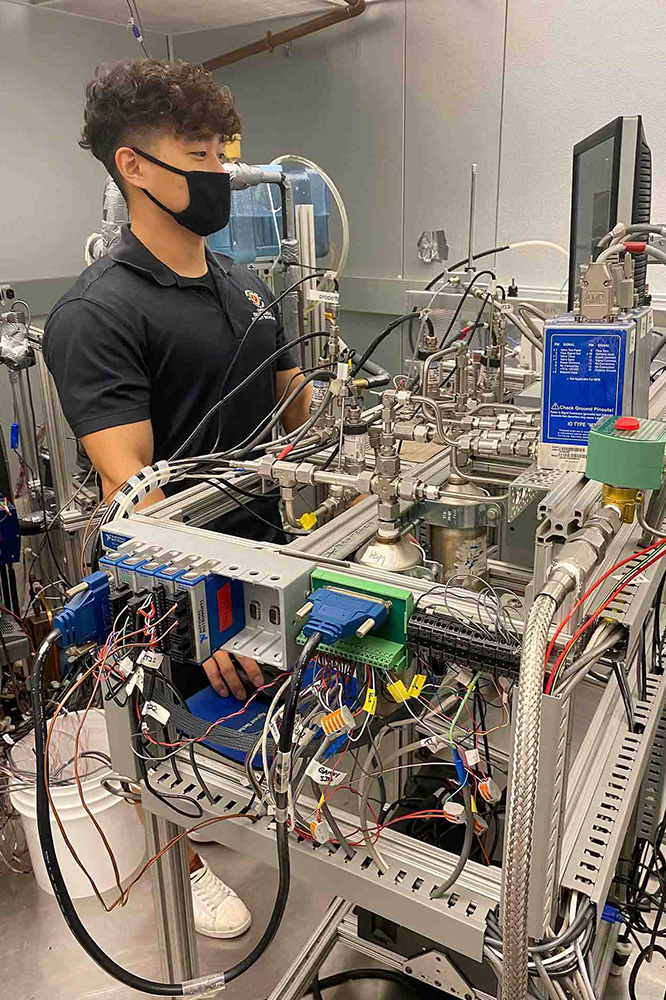Crank Up the AC, Not Global Warming
by Maggie Haslam for Maryland Today Ah, the sounds of summer: the soothing hum of the office HVAC system; the symphony of whirling window units adorning a high-rise apartment; the sigh of the freezer as you grab the last Popsicle. On a sweltering day, what’s music to your ears can be misery for the planet. Air conditioning alone releases 1.95 billion tons of carbon dioxide into the atmosphere each year, according to a study by the National Renewable Energy Laboratory, and the problem is projected to worsen as populations grow and urbanize on a warming planet. It doesn’t take an engineer to understand the math—but it might take one to find a solution. Ongoing research at the University of Maryland’s Center for Environmental Energy Engineering (CEEE) is revolutionizing the energy-guzzling inner workings of forced air that contribute to greenhouse gas emissions—like heat pumps, compressors, heat exchangers, and refrigerants—making them smaller, lighter, more efficient, and renewable. “Most people don’t really know how important cooling and heating technology is to carbon emissions, but also how critical it is to preserving our way of life,” said Research Professor Vikrant Aute, who directs the center along with his colleagues from the Department of Mechanical Engineering: Minta Martin Professor Reinhard Radermacher and Research Professor Yunho Hwang. “New technologies will be critical for a decarbonized future.” The International Energy Agency estimates there are a little over 2 billion air conditioners in the world, a number that is slated to balloon to 5.5 billion by 2050 as we keep nudging up the earth’s thermostat. How society will power them—while fulfilling a global commitment to reach net zero greenhouse gas emissions in the same time frame—is an urgent question for center researchers, who are working to advance next-generation, carbon-free technology, and improve efficiency. “People will spend $1,000 on a new iPhone, but it is hard to get that sort of enthusiasm for a more efficient air conditioner that will save hundreds of dollars in energy bills,” said Aute. “We want to make the iPhone of air conditioners.” Over its 30-year history, CEEE has been a research partner for top refrigeration manufacturers and international and federal agencies—including a long-standing relationship with the U.S. Department of Energy—collaborating to develop novel technologies and push guidelines for a global carbon-neutral approach. “When you turn on the air conditioner to make it cold in your house, you have to make it hot somewhere else,” said Postdoctoral Research Associate James Tancabel Ph.D. ’22, who has worked with CEEE for seven years. “It takes experts in the field to help people see that impact, and to design for that future.” UMD-cultivated technologies to protect the Earth’s climate are on the way. Here’s a look at what’s in store: Putting refrigerants on ice: From homes to food, hydrofluorocarbon refrigerants are the key to keeping things cool, but when leaked, they trap planet-warming heat in the atmosphere. A decade-long project between the center and materials science and engineering Professor Ichiro Takeuchi seeks to ditch refrigerants entirely by employing shape memory alloys, which can produce heat or cold through compression. One of the first research teams to develop a device using elastocaloric cooling and the global frontrunner in this technology, the team has a current prototype that can produce 100 watts of cooling capacity, enough to power a wine fridge; the team hopes to expand to window units, whole-house cooling systems and commercial HVACs. Grid relief: Advancements in thermal storage units—the energy reserves used by heating and cooling systems—aim to relieve pressure on the nation’s aging power grid through phase change materials, which release and absorb energy as they change from solid to liquid, like ice to water. Researchers are experimenting with different materials that could deliver more energy with significantly less storage: In hotter daytime hours when the grid is taxed, units tap into stored energy made during off-peak hours. While easing the grid is the immediate priority, the ultimate goal is to a renewable future, harvesting renewable energy like wind and solar to power buildings virtually carbon-free. Fuel cell-inspired cooling: CEEE researchers are working with materials science and engineering and chemical and biomolecular engineering Professor Chunsheng Wang and his team to develop a variety of ways to improve compressor technology and efficiency. These are the power-hungry and heavy systems that pressurize and circulate cooling refrigerant, but the group is developing a super-efficient one with no moving parts that employs a clever application of electricity and a membrane, similar to a fuel cell, significantly improving efficiency and reliability. Fewer parts also equal less weight, which reduces the carbon created in production and shipping. This story was adapted from "Ask Big Questions," featured in the Fall 2022 issue of Engineering at Maryland magazine.
Related Articles: April 18, 2023 Prev Next |


